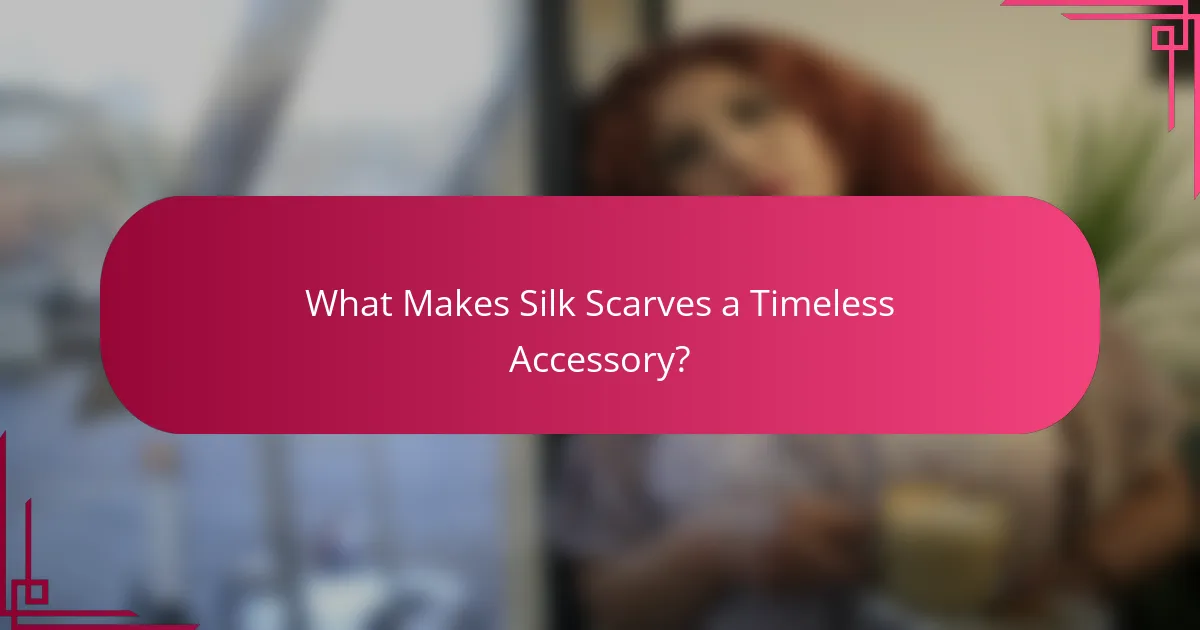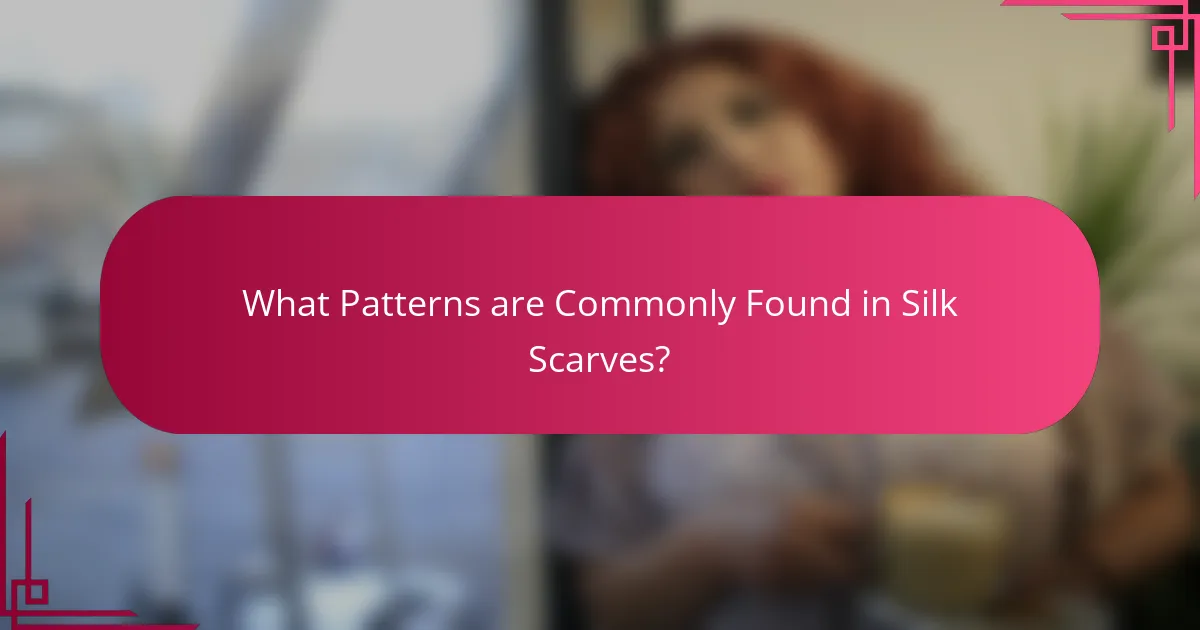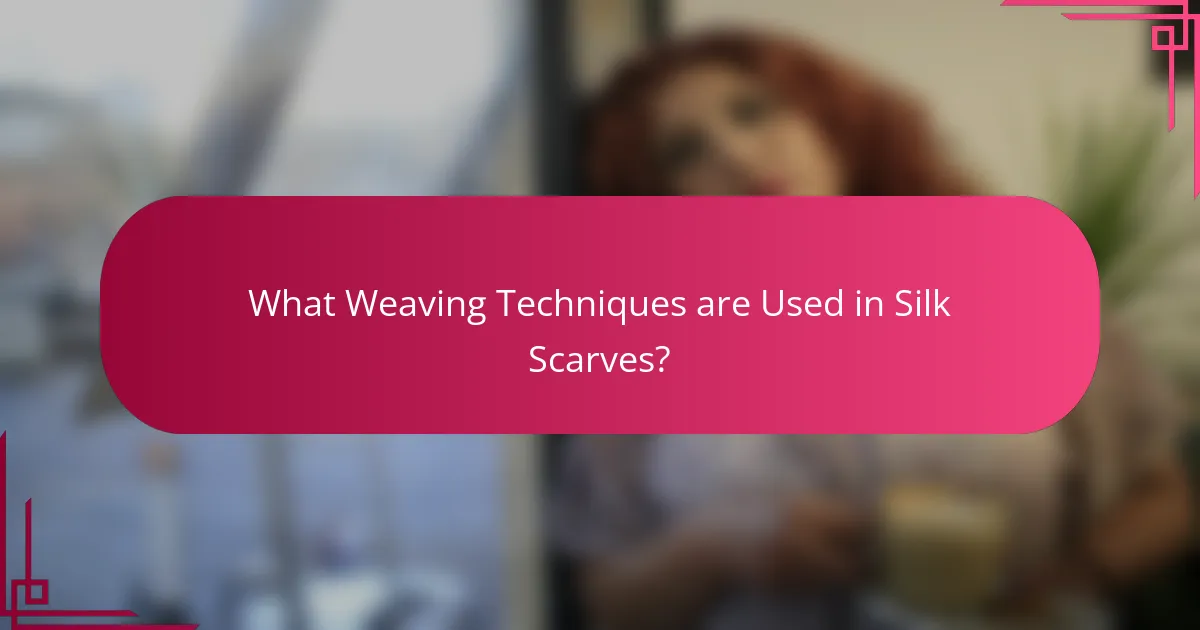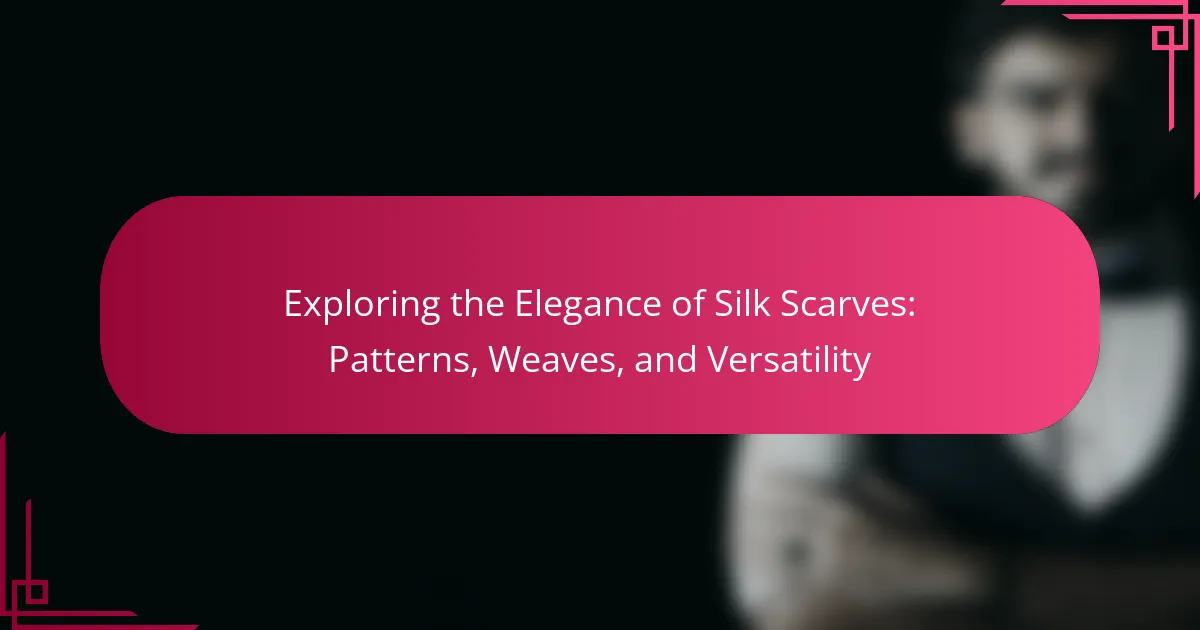Silk scarves are a luxurious and versatile fashion accessory known for their elegant texture and durability. This article explores the various patterns commonly found in silk scarves, such as paisley, floral, geometric, and abstract designs, highlighting their appeal across different styles and occasions. It also examines the weaving techniques used in crafting silk scarves, including plain weave, satin weave, and twill weave, which contribute to their unique textures and appearances. Overall, the combination of luxury, practicality, and diverse styling options makes silk scarves a staple in contemporary fashion.

What Makes Silk Scarves a Timeless Accessory?
Silk scarves are a timeless accessory due to their luxurious texture and versatility. They can elevate any outfit, making them suitable for various occasions. The natural sheen of silk adds an element of elegance that synthetic fabrics cannot replicate. Historically, silk has been associated with wealth and sophistication, dating back to ancient China. The durability of silk ensures that scarves can last for years, maintaining their beauty over time. Additionally, silk scarves come in a wide range of patterns and colors, appealing to diverse fashion tastes. Their ability to be styled in multiple ways, such as around the neck, wrist, or hair, enhances their practicality. This combination of luxury, durability, and versatility solidifies silk scarves as a staple in fashion.
How Do Silk Scarves Enhance Personal Style?
Silk scarves enhance personal style by adding elegance and versatility to outfits. They can be worn in various ways, such as around the neck, as a headband, or tied to a handbag. This adaptability allows individuals to express their personal style uniquely. Silk scarves come in a range of colors and patterns, enabling customization to fit different occasions and moods. The luxurious texture of silk elevates the overall appearance of any outfit. Historical fashion icons, like Audrey Hepburn, have popularized silk scarves, showcasing their timeless appeal. Research indicates that accessories like silk scarves can significantly impact perceived style and sophistication.
What are the different ways to wear a silk scarf?
A silk scarf can be worn in various stylish ways. One common method is to tie it around the neck as a classic accessory. This adds a touch of elegance to any outfit. Another way is to wear it as a headband, which provides a chic look while keeping hair in place. Additionally, a silk scarf can be knotted around the wrist, serving as a fashionable bracelet. It can also be used as a belt, enhancing the waistline of dresses or pants. For a more sophisticated style, draping it over the shoulders can create a luxurious shawl effect. Lastly, it can be tied to the handle of a handbag for a pop of color and style. Each of these methods showcases the versatility of silk scarves in fashion.
How can silk scarves be styled for various occasions?
Silk scarves can be styled for various occasions by using different tying techniques and placements. For formal events, draping a silk scarf around the neck and letting it hang elegantly can add sophistication. For casual outings, tying the scarf in a loose knot or wearing it as a headband can create a relaxed look. During colder months, wrapping the scarf around the shoulders or layering it over a coat provides warmth and style. For beach outings, a silk scarf can be used as a sarong or tied around a hat for added flair. Each styling method enhances the versatility of silk scarves, making them suitable for diverse settings.
What are the Key Attributes of Silk Scarves?
Silk scarves are known for their luxurious texture and vibrant colors. They are made from natural silk fibers, which provide a soft and smooth feel. The key attributes include breathability, allowing for comfort in various climates. They also exhibit a natural sheen, enhancing their visual appeal. Silk scarves can be printed with intricate designs, showcasing artistic patterns. Their lightweight nature makes them easy to wear and style. Additionally, silk is durable, maintaining its quality over time with proper care. These attributes contribute to the overall elegance and versatility of silk scarves in fashion.
What are the benefits of using silk as a material?
Silk is a luxurious material known for its numerous benefits. It is soft and smooth, providing comfort against the skin. Silk has a natural sheen, enhancing its aesthetic appeal. The material is lightweight, making it easy to wear and style. Silk is also breathable, helping to regulate temperature in various climates. Additionally, it has moisture-wicking properties, keeping the skin dry. Silk is durable and can last for many years with proper care. Its hypoallergenic nature makes it suitable for sensitive skin. These attributes contribute to silk’s popularity in fashion and home textiles.
How does the quality of silk affect the elegance of a scarf?
The quality of silk significantly enhances the elegance of a scarf. High-quality silk has a smooth texture and a natural sheen. This creates a luxurious appearance that elevates the overall look of the scarf. Additionally, finer silk fibers allow for intricate patterns and designs. These details contribute to a more sophisticated aesthetic. In contrast, lower quality silk may appear dull and feel rough. This can detract from the elegance of the scarf. Studies show that silk with a higher momme weight indicates better quality. A momme weight of 19 or higher is often associated with premium silk products. Therefore, the quality of silk directly impacts the elegance and visual appeal of a scarf.

What Patterns are Commonly Found in Silk Scarves?
Common patterns found in silk scarves include paisley, floral, geometric, and abstract designs. Paisley patterns feature intricate teardrop shapes and are often associated with traditional designs. Floral patterns display various flowers and leaves, adding a touch of nature to the fabric. Geometric patterns use shapes like triangles and circles, creating a modern aesthetic. Abstract designs offer a unique and artistic flair, often combining multiple colors and forms. These patterns are popular due to their versatility and ability to complement various outfits. Silk scarves featuring these patterns can enhance both casual and formal attire.
How Do Patterns Influence the Appeal of Silk Scarves?
Patterns significantly enhance the appeal of silk scarves. They add visual interest and depth to the fabric. Unique designs can evoke emotions and convey personal style. For instance, floral patterns often symbolize femininity and grace. Geometric patterns can suggest modernity and sophistication. Additionally, cultural motifs can connect wearers to heritage or tradition. According to a study by the Journal of Fashion Marketing and Management, patterns influence consumer preferences and purchasing decisions. This indicates that the right pattern can increase the desirability of silk scarves.
What are the most popular patterns used in silk scarves?
The most popular patterns used in silk scarves include paisley, floral, geometric, and animal prints. Paisley patterns feature intricate, teardrop-shaped designs originating from Persian textiles. Floral patterns showcase various flowers and botanical elements, adding a touch of nature. Geometric patterns consist of shapes and lines, creating a modern aesthetic. Animal prints mimic the fur or skin of animals, providing a bold statement. These patterns are favored for their versatility and ability to complement various outfits.
How do cultural influences shape scarf patterns?
Cultural influences significantly shape scarf patterns through historical, artistic, and social contexts. Different cultures use unique motifs and colors that reflect their heritage. For instance, Indian scarves often feature intricate paisley designs, representing traditional art forms. In contrast, Japanese scarves may include elements like cherry blossoms, symbolizing beauty and transience. These patterns often tell stories or convey cultural values. Additionally, regional materials and weaving techniques contribute to the distinctiveness of scarf designs. The popularity of certain styles can also be traced to cultural exchanges through trade and globalization, further diversifying scarf patterns.
What Techniques are Used to Create Patterns on Silk Scarves?
Silk scarves are often patterned using techniques such as screen printing, digital printing, and hand painting. Screen printing involves applying ink through a mesh screen to create designs. Digital printing allows for intricate patterns to be printed directly onto the fabric using specialized printers. Hand painting involves artisans applying dyes directly onto the silk, resulting in unique, one-of-a-kind designs. Additionally, techniques like tie-dye and batik can also be employed to create interesting patterns. Each method contributes to the aesthetic appeal and uniqueness of the silk scarf.
What is the process of printing patterns on silk?
The process of printing patterns on silk involves several key steps. First, the silk fabric is prepared by washing and stretching it. This ensures a smooth surface for printing. Next, a design is created and transferred onto a printing screen or block. The ink used is often a specialized dye suitable for silk.
Once the design is ready, the printing process begins. The ink is applied to the silk through the screen or block, transferring the design onto the fabric. After printing, the silk is heat-set to fix the dye, ensuring durability and vibrancy.
Finally, the printed silk is washed to remove any excess dye. This process results in beautifully patterned silk that retains its luxurious feel. Historical methods, such as silk screen printing, have been used for centuries, showcasing the artistry involved in this craft.
How do hand-painted patterns differ from printed ones?
Hand-painted patterns differ from printed ones in their unique creation process. Hand-painted patterns involve an artist applying paint directly onto the fabric. This method allows for individual expression and variation in each piece. In contrast, printed patterns are produced using screens or digital methods. This results in uniformity across multiple items. Hand-painted designs often showcase intricate details and textures. Printed patterns can achieve consistency and efficiency in production. The distinctiveness of hand-painted patterns adds to their artistic value. This uniqueness is often sought after in luxury fashion items like silk scarves.

What Weaving Techniques are Used in Silk Scarves?
Silk scarves are crafted using various weaving techniques. Common techniques include plain weave, satin weave, and twill weave.
Plain weave is the most basic technique, alternating the warp and weft threads. This creates a simple, flat fabric. Satin weave involves floating the weft threads over multiple warp threads, resulting in a smooth, glossy surface.
Twill weave creates a diagonal pattern by interlacing the threads in a staggered manner. Each technique offers distinct textures and appearances.
These weaving methods are fundamental in determining the final look and feel of silk scarves.
How Do Different Weaves Impact the Texture of Silk Scarves?
Different weaves significantly impact the texture of silk scarves. Each weave type alters the feel and appearance of the fabric. For instance, satin weaves create a smooth, glossy surface. This gives satin silk scarves a luxurious look and a soft touch. On the other hand, twill weaves produce a diagonal pattern. This results in a more textured, durable fabric. Additionally, chiffon weaves create a lightweight and airy texture. This makes chiffon silk scarves flowy and delicate. The choice of weave thus directly influences how a silk scarf drapes and feels against the skin.
What are the various weaving techniques used for silk scarves?
Silk scarves are crafted using various weaving techniques. Common techniques include plain weave, satin weave, and twill weave. Plain weave is the simplest method, alternating warp and weft threads. Satin weave creates a smooth surface by floating warp threads over weft threads. Twill weave produces a diagonal pattern through a structured interlacing of threads. Each technique affects the texture and appearance of the silk scarf. For instance, satin weave often results in a shiny finish, while twill weave offers durability. These techniques have been historically significant in textile production, influencing fashion and design trends.
How does the weave affect the durability of a silk scarf?
The weave of a silk scarf directly influences its durability. Different weaves, such as satin or twill, affect the fabric’s strength and resilience. Satin weaves create a smooth surface but may be more prone to snagging. Twill weaves provide a diagonal pattern that enhances durability and resistance to wear. The density of the weave also impacts how well the scarf withstands stress and everyday use. A tighter weave generally results in a more robust scarf that can endure frequent handling. Conversely, a looser weave may lead to quicker fraying and damage over time. Thus, the choice of weave is crucial for maintaining the longevity of a silk scarf.
What Are the Versatile Uses of Silk Scarves?
Silk scarves have versatile uses across fashion and lifestyle. They can be worn as headwraps to protect hair or enhance style. Silk scarves serve as neck accessories, adding elegance to outfits. They can be tied to bags for a chic look. Additionally, silk scarves function as belts, providing a unique touch to attire. They can also be used as wrist accessories, showcasing personal style. In home decor, silk scarves can be displayed as wall art or table runners. Their lightweight nature makes them suitable for various climates and occasions.
How can silk scarves be utilized beyond fashion?
Silk scarves can be utilized beyond fashion as versatile home decor items. They can be used as wall hangings, adding color and texture to a room. Silk scarves also serve as table runners, enhancing dining experiences with elegance. Additionally, they can be transformed into cushion covers, providing a unique touch to furniture. Silk scarves are effective as gift wraps, offering a luxurious alternative to traditional wrapping paper. They can even be used in crafting, such as making hair accessories or jewelry. Their soft texture and vibrant patterns make them suitable for various creative applications.
What are creative ways to incorporate silk scarves into home decor?
Silk scarves can be creatively incorporated into home decor in various ways. One method is to use them as wall art. Framing a silk scarf allows it to serve as a vibrant piece of decor. Another option is to use scarves as table runners. They add a touch of elegance to dining tables. Additionally, silk scarves can be tied around furniture legs for a decorative accent. This approach enhances the aesthetic of chairs or tables.
Using scarves as cushion covers is another creative idea. This method provides a unique and soft texture to seating areas. Scarves can also be draped over lampshades. This creates a soft, diffused light effect in a room. Lastly, silk scarves can be incorporated into wreaths or floral arrangements. They add color and sophistication to seasonal decorations.
What Tips Can Help You Choose the Perfect Silk Scarf?
To choose the perfect silk scarf, consider the fabric quality. High-quality silk has a luxurious feel and sheen. Check the weight of the scarf; heavier silk often indicates better quality. Look for vibrant colors and patterns that suit your style. Ensure the scarf’s size fits your intended use, whether for fashion or warmth. Examine the edges; hand-rolled hems indicate superior craftsmanship. Research reputable brands known for their silk products. Finally, consider the care instructions to maintain the scarf’s beauty over time.
Silk scarves are a luxurious and versatile fashion accessory known for their elegant texture and rich history. This article explores the various attributes of silk scarves, including their durability, patterns, and weaving techniques, highlighting how these elements enhance personal style and adaptability for different occasions. Additionally, it discusses creative uses of silk scarves beyond fashion, such as in home decor, and provides tips for selecting the perfect scarf. The comprehensive overview covers both the aesthetic and practical aspects of silk scarves, emphasizing their timeless appeal in modern fashion.
